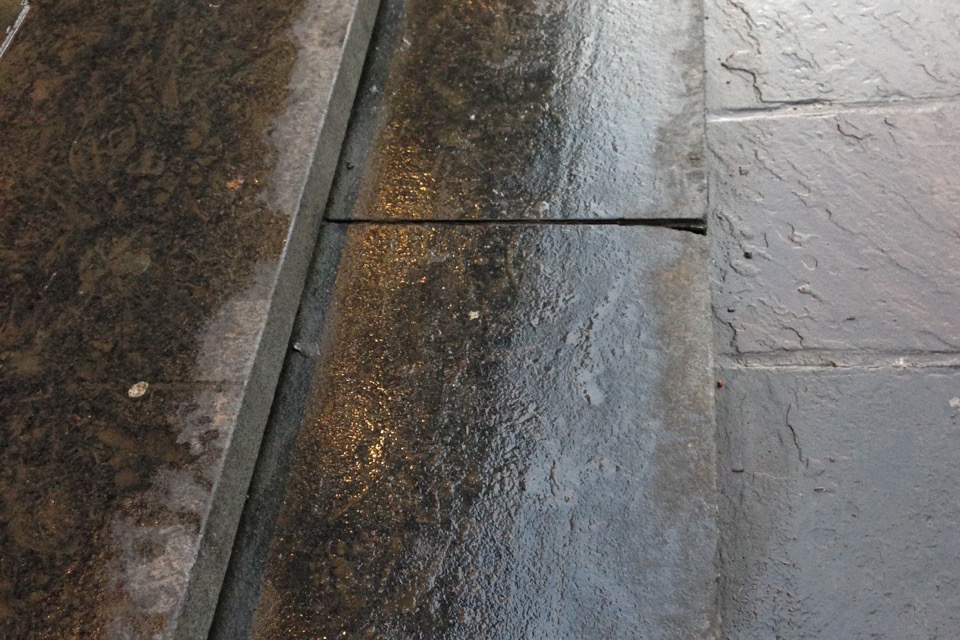A New Orleans Lesson on Stone and Water

If you live anywhere in a warm, humid coastal area, you’re no doubt familiar with wet concrete in winter. Some days you walk outside and find the carport slab is soaking wet. How did it happen? Did rain blow into the carport? If it’s not rain, is it moisture from the ground that came up through the concrete? Could it be condensation from the water vapor in the air? Let’s take a look.
I took the photo above on a February day in New Orleans a few years ago and it perfectly demonstrates the physics of this phenomenon. What you’re looking at are the stone steps and pavers near Jackson Square. They were mostly wet but the water didn’t get there from rain or any other liquid water source above the stone.
Could the water have come from below? The photo above doesn’t eliminate that possibility. Notice the nose of the steps. That part of the stone was dry. It wasn’t directly in contact with the ground, having a bit of air beneath, so maybe the water did come from below.
But no, that’s not the answer either. Here’s another photo taken nearby at about the same time. The sidewalk and steps were completely dry. The critical difference between the two locations was shade. The dry area was open to the sky. That kept the stone warmer than the other stone, which was under tree cover.

Let’s go back at the lead photo. The stone there was wet because of condensation. The nose of the steps was dry because it was warmer. That part of the stone had air on three sides. That warmed it up enough that it could be above the dew point.
When does this happen? I’ve spent many years of my life in Houston, south Louisiana, and Florida, so I’m familiar with this condition. It happens in winter, after there’s been a cold snap. A cold front comes through and chills the ground, the sidewalks, and the concrete slabs. Then it moves out, being replaced by a mass of warm, humid air. The air temperature rises into the 60s or 70s Fahrenheit, maybe even 80° F.
The dew point of the water vapor in that air can be 70° F or higher. When it finds that cold concrete or stone in contact with the ground, you get condensation. It’s possible to see condensation on open areas but you’ll more often see it on shaded surfaces because those areas stay cool longer.
When you can look at something like that and figure out what’s going on, you can figure out all kinds of moisture problems that occur in buildings, too.
Related Articles
Dew Point — A More Meaningful Measure of Humidity?
Why Is Fall a Good Time of Year for Window Condensation?
Buried Ducts Risk Condensation in Humid Climates
NOTE: Comments are moderated. Your comment will not appear below until approved.
This Post Has 3 Comments
Comments are closed.

I have a three pour slab
I have a three pour slab under a porch, the center (troweled finish) was original while the others (lightly brushed) were poured years later. The center slab ‘sweats’ heavily while the adjacent ones are dry. what a joy…
John, I think they probably
John, I think they probably all sweat about the same. The brushed ones may absorb the water better but they mainly provide better traction and have more surface area where the condensation can “hide.”
Pertaining to nighttime
Pertaining to nighttime radiant cooling of solid surfaces like concrete slabs and porches to a clear sky in a southern winter as compared to concrete underneath a carport or covered porch, and with no wind, the unsheltered concrete areas in my observation would cool faster to the night sky than the sheltered concrete beneath a roof.
However, on the following sunny day, it is true the shaded areas would be slower to warm up than the concrete exposed to sky and solar radiant gain. The timing of the shift from cold dry air advection to warm, moist air advection would also factor in as to when and how intensely moisture in the air would condense on the concrete surfaces. Or, in psychrometric terms, when the dew point temperature of the air over the concrete increases above the surface temperature of the concrete, condensation occurs.
We had quite a bit of the cold dry air front/warm moist air front battle locally this year. My carport slab following the warm front passing would be so wet with condensation it was a slip hazard. One particular warm front was quite strong and sudden, so not only did my shaded carport slab get soaked, about every other horizontal surface outdoors did, also, shaded or not.